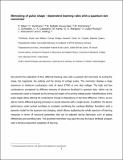Files in this item
Mimicking of pulse shape-dependent learning rules with a quantum dot memristor
Item metadata
| dc.contributor.author | Maier, P. | |
| dc.contributor.author | Hartmann, Fabian | |
| dc.contributor.author | Rebello Sousa Dias, M. | |
| dc.contributor.author | Emmerling, M. | |
| dc.contributor.author | Schneider, C. | |
| dc.contributor.author | Castelano, L. K. | |
| dc.contributor.author | Kamp, M. | |
| dc.contributor.author | Marques, G. E. | |
| dc.contributor.author | Lopez-Richard, V. | |
| dc.contributor.author | Worschech, L. | |
| dc.contributor.author | Höfling, Sven | |
| dc.date.accessioned | 2016-09-26T11:30:15Z | |
| dc.date.available | 2016-09-26T11:30:15Z | |
| dc.date.issued | 2016-10-07 | |
| dc.identifier | 246059779 | |
| dc.identifier | a1f9d482-48cc-4b25-b95e-765a39b8a679 | |
| dc.identifier | 84989834075 | |
| dc.identifier | 000386155100022 | |
| dc.identifier.citation | Maier , P , Hartmann , F , Rebello Sousa Dias , M , Emmerling , M , Schneider , C , Castelano , L K , Kamp , M , Marques , G E , Lopez-Richard , V , Worschech , L & Höfling , S 2016 , ' Mimicking of pulse shape-dependent learning rules with a quantum dot memristor ' , Journal of Applied Physics , vol. 120 , no. 13 , 134503 . https://doi.org/10.1063/1.4963830 | en |
| dc.identifier.issn | 0021-8979 | |
| dc.identifier.uri | https://hdl.handle.net/10023/9554 | |
| dc.description | The authors gratefully acknowledge financial support from the European Union (FPVII (2007-2013) under grant agreement n° 318287 Landauer) as well as the state of Bavaria. The Brazilian authors acknowledge the support of CNPq. V. L.-R. acknowledges the support of FAPESP (grants 2014/02112-3 and 2015/10765-0). | en |
| dc.description.abstract | We present the realization of four different learning rules with a quantum dot memristor by tuning the shape, the magnitude, the polarity and the timing of voltage pulses. The memristor displays a large maximum to minimum conductance ratio of about 57000 at zero bias voltage. The high and low conductances correspond to different amounts of electrons localized in quantum dots, which can be successively raised or lowered by the timing and shapes of incoming voltage pulses. Modifications of the pulse shapes allow altering the conductance change in dependence on the time difference. Hence, we are able to mimic different learning processes in neural networks with a single device. In addition, the device performance under pulsed excitation is emulated combining the Landauer-Büttiker formalism with a dynamic model for the quantum dot charging, which allows explaining the whole spectrum of learning responses in terms of structural parameters that can be adjusted during fabrication such as gating efficiencies and tunneling rates. The presented memristor may pave the way for future artificial synapses with a stimulus-dependent capability of learning. | |
| dc.format.extent | 858662 | |
| dc.language.iso | eng | |
| dc.relation.ispartof | Journal of Applied Physics | en |
| dc.subject | QC Physics | en |
| dc.subject | TK Electrical engineering. Electronics Nuclear engineering | en |
| dc.subject | NDAS | en |
| dc.subject.lcc | QC | en |
| dc.subject.lcc | TK | en |
| dc.title | Mimicking of pulse shape-dependent learning rules with a quantum dot memristor | en |
| dc.type | Journal article | en |
| dc.contributor.institution | University of St Andrews. School of Physics and Astronomy | en |
| dc.contributor.institution | University of St Andrews. Condensed Matter Physics | en |
| dc.identifier.doi | https://doi.org/10.1063/1.4963830 | |
| dc.description.status | Peer reviewed | en |
This item appears in the following Collection(s)
Items in the St Andrews Research Repository are protected by copyright, with all rights reserved, unless otherwise indicated.

